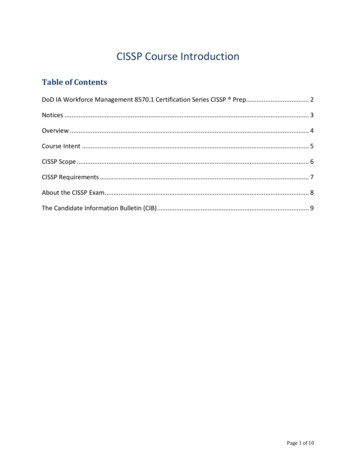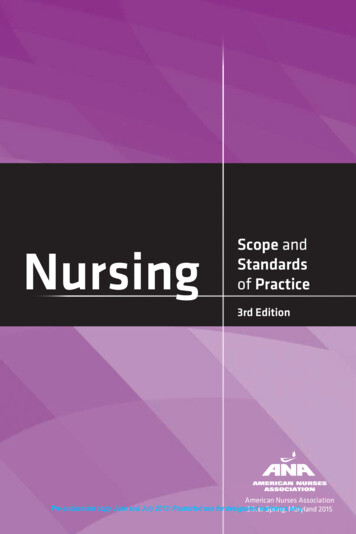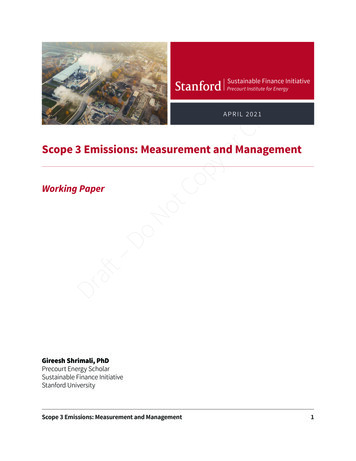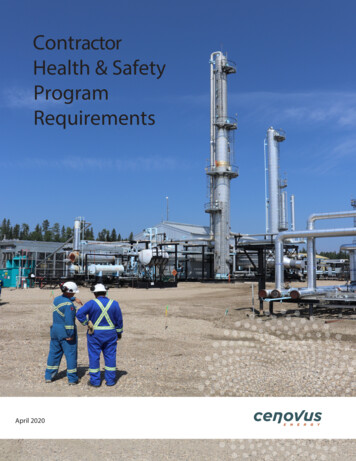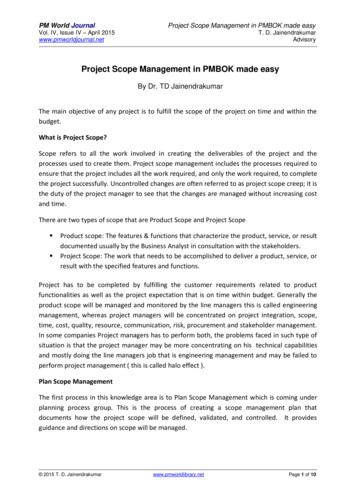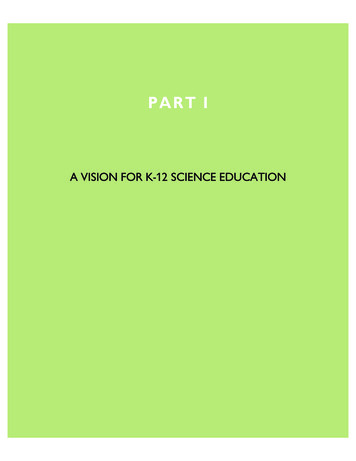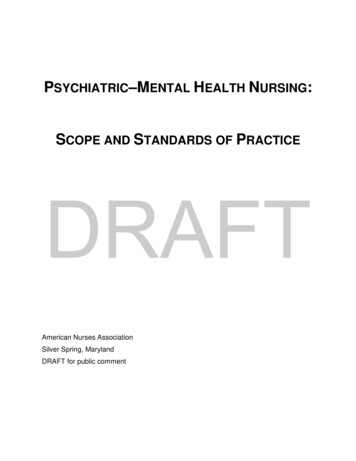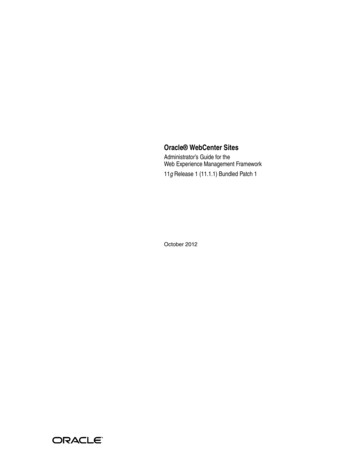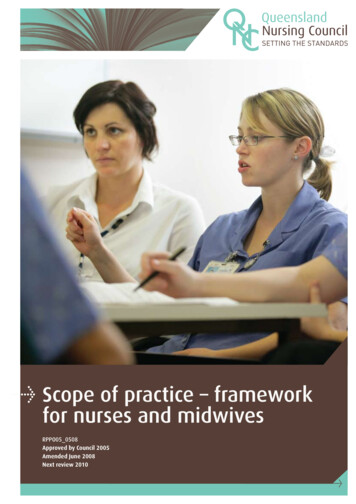
Transcription
Scope of practice – frameworkfor nurses and midwivesRPPO05 0508Approved by Council 2005Amended June 2008Next review 2010
Scope of practice – framework for nurses and midwivesUpdated 2005ContentsIntroductionOverview and exclusions. 3The Queensland Nursing Council(Council) is responsible foradministering the Nursing Act 1992(Queensland). Council’s role is to helpensure safe and competent nursingand midwifery practice.Section A – Role relationships of health care personnel. 6Diagram 1: Map of role relationships among health care personnel. 61.0 Clients. 62.0 Licensed nurses and midwives. 62.1 Registered nurse (RN). 62.2 Midwife. 72.3 Enrolled nurse (EN). 72.4 Nurse practitioner. 73.0 Other health professionals. 74.0 Unlicensed health care workers. 75.0 Aboriginal health workers and Torres Strait Islander health workers. 7Section B - Nursing and midwifery practice. 8Diagram 2: The continuum of practice. 81.0 Nursing and midwifery practice. 82.0 Scope of practice. 93.0 Key practice standards for RNs, ENs and midwives. 9Table 1: Key professional practice standards. 94.0 The continuum of practice. 10Section C – The three sets of principles. 11Diagram 3: Scope of practice of nurses and midwives. 11Set 1: P rinciples for advancing the scope of practice of registered nurses,enrolled nurses and midwives. 12Set 2: Principles for expanding the scope of practice of registered nurses and midwives.13Set 3: Principles for delegating to unlicenced health care workers (HCWs). 14Section D – Definitions. 151.0 Accountability and responsibility. 152.0 Activity. 153.0 Clients. 154.0 Competence /competent. 165.0 Consultation and planning. 166.0 Context of practice. 167.0 Delegation. 17Table 2: Delegation summary. 178.0 Education. 189.0 Standards. 1810.0 Supervision. 18Do you need more detailed information, clarification or examples?Throughout this document icons point you to other sources ofinformation: Framework information sheetsWebsiteand case studiesOne of Council’s functions (Section7(b) of the Nursing Act 1992) is todetermine the scope of practice forQueensland’s nurses and midwives.To fulfil this function, Council hasdeveloped the Scope of practice –framework for nurses and midwives(The Framework).
Scope of practice – framework for nurses and midwivesUpdated 2005Overview and exclusionsNurses’ and midwives’ scope of practiceSince its first release in 1998, the Scope of practice – frameworkfor nurses and midwives (Framework) has proven to be a valid,reliable and useful decision-making tool.In this 2005 version, greater emphasis has been placed on the:central role clients play in any scope of practice decision ifferences in the roles and responsibilities of health caredteam membersimportance of professional competency standardsbenefits of collaboration and teamwork.The scope of practice for nurses and midwives cannot bedefined as a simple list of tasks or procedures.The Framework acknowledges the professionalismof nurses and midwivesTo help ensure safe and competent practice, all Australiannurses and midwives must hold a licence. To obtain this annuallicence, each applicant must meet levels of competence thatare equivalent to the Australian core competency standards. InQueensland, the Framework, used as a decision-making tool,builds on these competency standards because it enables theprofession, in collaboration with health service providers, toadvance or expand nurses’ and midwives’ scope of practice in aplanned and structured way.Nurses and midwives are widely respected health careproviders, combining education and professionalism with acaring concern for clients. The Framework complements thekey professional characteristics of accountability for practice,advocacy, autonomy and collaboration. In particular, it supportsprofessional accountability when each individual uses theirprofessional discretion to make scope of practice decisions.Consumer confidenceClients and health service providers can be confident that thedecisions nurses and midwives make using the Frameworkwill result in the maintenance of the high standard of care thatclients expect from the professions.In rapidly evolving health care environments, nurses and midwivesmust frequently incorporate new knowledge and skills into theirpractice. Therefore, a list of approved activities would quicklybecome out of date. The Framework’s more sustainable approachof providing a broad, principle-based definition, allows individualnurses and midwives in any setting to reflect on their current“scope of practice” by comparing it with the definition below.The scope of nursing and midwifery practice is that whichnurses and midwives are educated, competent andauthorised to perform. The actual scope of an individualnurse’s or midwife’s practice is influenced by the:context in which they practiceclients’ health needsl evel of competence, education and qualifications ofthe individual nurse or midwifeservice providers’ policies.Other information in the FrameworkThe Framework also explains: urses’ and midwives’ accountabilities and responsibilities innrelation to delegated activities ow nurses and midwives maximise their contribution tohclient care by contributing to the professional development ofothers and by developing their own careerst he decision-making process that RNs and midwives use(Set 3) when they delegate care activities to unlicensedhealth care workers (HCWs).Any changes in a nurse’s or midwife’s scope of practice mustprimarily be aimed at meeting clients’ health needs. For example: n enrolled nurse (EN) using the Principles for advancing theAscope of practice of RNs, ENs and midwives, (Set 1) can safelyaccept a delegation that advances their scope of practice tomeet an individual client’s health needs registered nurse (RN) or midwife using the Principles forAexpanding the scope of practice of registered nurses andmidwives (Set 2), can incorporate a new health service intotheir scope of practice to provide clients with better access tohealth care.3
Scope of practice – framework for nurses and midwivesUpdated 2005Exclusions - when the Framework does not applyB) Some aspects of drug administration by ENsA nurse or midwife can use the relevant principles to determinewhat activities or tasks they can delegate or accept. But, in thefollowing circumstances the Framework should not be used:The Health (Drugs and Poisons) Regulations 1996 authorisescertain individuals to administer, prescribe or supply drugs.1.0 Actions in an emergencyNothing in this document can be construed as preventing anurse, midwife or other person from taking appropriate action inan emergency.2.0 A ctivities that a registered nurse or midwifecannot delegateCouncil has excluded some nursing and midwifery activities fromthe Framework’s decision-making processes and allocated theseactivities (see A, B, C below) to the sole domain of RNs or midwives.When determining what should be excluded, Councilconsidered that: Ns and midwives making practice decisions have moreRautonomy than ENs. ENs contribute to care planning butmay not act independently because the RN or midwiferetains overall responsibility. For example, when ENs accept adelegation, they may not re-delegate that activity to anotherperson. This is because RNs and midwives are responsible forensuring the quality of the work through their involvementin teaching, competence assessment, supervision and theevaluation of clients’ outcomes.t he national competency standards give certainresponsibilities exclusively to RNs and midwivest he Nursing Act 1992 contains some practice restrictions(detailed in section C below).The following activities (A, B, C) cannot bedelegated to people who are not RNs or midwives:A) Care planning and delegation of activities from anursing/midwifery care plani. The comprehensive assessment of individuals and groups.ii. The interpretation of assessment data.iii. T he formulation and documentation of a plan of careincluding establishing the priorities of care.iv. T he evaluation of client responses and other information,for the purposes of making changes to the care plan.v. The responsibility for the delegation to others of activitiesfrom the nursing or midwifery care plan.See Council’s website for information on:delegation and clinically-focused supervision.C) Legislated practice restrictionsThe Nursing Act 1992 includes the following restricted practiceprovisions (amendments 2005): ractising nursing is restricted to registered and enrolledPnurses and others who are authorised to practise nursing byCouncil (Section 77H).C aring for women in childbirth1 is a practice restricted tomidwives (authorised by Council). (Section 77I)Council may prosecute individuals for unauthorised (unlicensed)nursing practice or for caring for a woman in childbirth withoutbeing authorised as a midwife. There are some exceptions listedin the Nursing Act 1992.Nursing and midwifery practice cannot be defined as a simplelist of tasks. Therefore, Council will consider every case ofalleged unauthorised practice on its own merits. When making adecision on what is unauthorised practice, Council may take intoaccount the:practice restrictions in the Acti nformation contained within this document –Scope of practice framework for nurses and midwivesclient’s needs and expectationsnature of the activityc ontext of the alleged breach, including client outcomes andthe organisational environmentr esponsibilities and actions of any nurse or midwife involvedin the matter.See Council’s website for information on:nursing practice restrictionsmidwifery practice restrictions.A midwife must not delegate the responsibility for midwiferycare planning to any person who is not a midwife. RNs or ENsundertaking activities delegated to them from a midwifery careplan must work with the support and supervision of a midwife.An RN must not delegate the responsibility for nursing careplanning to any person who is not an RN. Direct-entry midwivesor ENs undertaking activities delegated to them from a nursingcare plan must work with the support and supervision of an RN.1C hildbirth is defined in the Nursing Act 1992 as the process of labour and delivery beginning with uterine contractions and ending with the expulsion of the placenta andmembranes from the woman giving birth.4
Scope of practice – framework for nurses and midwivesUpdated 2005Responsibility for using the Framework in teamcare settingsDisagreement over the application ofthe FrameworkIn team care settings2, it is important for each nurse or midwifeto establish if they are responsible for the care or activitiescarried out by others.Each nurse or midwife is individually responsible for decisionsmade in relation to nursing or midwifery care plans.If an RN or midwife identifies that they are responsible,then the activity must be regarded as a delegated nursingor midwifery activity and they must apply the Frameworkprinciples. (See Section C)To help establish who is responsible and to clarify the RN /midwife to client relationship, the RN or midwife could:c heck their job description/contract of employmentc onsider if the contracting client and/or the employer who iscontracted to supply the service, or the funder of the serviceexpects that the RN or midwife is responsible for:- c are planning - assessment, planning and/or evaluation ofthe client’s responses/outcomes- t he assessment, planning and/or evaluation of the activity- c linically supervising HCWs carrying out the task (that is, theHCWs are working under the RN’s or midwife’s direction).See Council’s website for information on: elegation and clinically-focused supervisiondof unlicensed health care workers.Infrequently, disagreements arise over the application of theFramework. For example, an RN may use the relevant scopeof practice principles and decide that, in their professionaljudgement, they disagree with their employer’s direction todelegate care to another level of health care provider.To resolve such a disagreement the RN could take one or moreof the following actions: efer all parties to the definitions of accountability andRresponsibility in Section D and the extra information onCouncil’s website. dvise all parties that, if a licensed nurse or midwife carries Aout an action that is contrary to their professional judgement,they may risk disciplinary action by Council. Consequently,employers and other staff or management involved may riskbeing prosecuted under section 121A of the Nursing Act 1992.Section 121A outlines the penalties for assisting or coercing anurse or midwife to engage in unprofessional conduct.S eek clarification from Council’s professional staff about theapplication of the Framework. S eek advice from the relevant union and/ora legal representative.See Council’s website for information on: r esolving disagreement over applicationof Framework enalties for assisting or coercing a nursepor midwife to engage in unprofessionalconduct, Section 121A.2Team care settings - such as RNs working with unlicensed HCWs in residential aged care or midwives working with RNs and ENs in maternity settings.5
Scope of practice – framework for nurses and midwivesUpdated 2005Section A – Role relationships of healthcare personnelThis section includes information about the different categoriesof nurses, midwives, and health care personnel.In addition Diagram 1: Map of role relationships among healthcare personnel (pictured at the bottom of this page) emphasisesthe collaborative relationships which exist between health carepersonnel. It also shows the role that RNs and midwives have indelegating care activities.The health care teamTo meet clients’ complex health care needs, nurses andmidwives work within a health care team which includes otherhealth professionals and unlicensed HCWs. To be effective, teamcare must be based on mutual understanding, trust, respect andco-operation. Therefore, the contribution and knowledge of eachteam member is valued and respected.1.0 ClientsClients are individuals, groups, or communities who receivenursing or midwifery care. They include patients and consumers,as well as their families or representatives.Licence endorsementsAppropriately qualified nurses are able to apply for anendorsement on their licence that can authorise them to practise:1. as a midwife2. as a nurse practitioner3. as a mental health nurse4. to perform specific activities. For example, RNs who hold adrug therapy protocol (DTP) endorsement and who work inan approved program, can independently supply medicationto clients, without the need for the client to be assessed by adoctor. Also, ENs can obtain an endorsement which authorisesthem to administer prescribed, restricted and scheduled(Schedule 4 and 8) drugs.Annual renewal of licenceEach year, when nurses and midwives apply to renew theirlicences, they must reflect on their practice and declare theyare competent to practise safely. This process supports theprofessional requirement for ongoing competence developmentand learning. Council randomly audits applicants to ensure thatthey can provide evidence to support their declaration.On Council’s online register any person can check thedetails of a nurse’s or midwife’s licence.2.0 Licensed nurses and midwivesThe Nursing Act 1992 stipulates that the only people who canuse the titles registered nurse, enrolled nurse or midwife arepeople who are permitted by Council to practise nursing ormidwifery. (Section 141)2.1 Registered nurse (RN)Licence to practiseIn Queensland, the RN course is a three year/six semester bachelordegree at a Council accredited university/education provider.Every nurse or midwife must hold a licence that is evidence thatthey have been permitted to practise in Queensland. Councilissues a licence on the basis of the applicant’s qualifications,fitness (suitability) and competence for practice.Diagram 1:Map of rolerelationships amonghealth care personnelAn RN is a person with appropriate educational preparation andcompetence for practice, who is registered and licensed underthe Nursing Act 1992 to practise nursing in aborationRefers to working inpartnership withclients and membersof the health care teamfor the benefit of clients.DelegationIs the conferring ofauthority on a person toperform activitiesOther healthprofessionalsEnrollednurseUnlicensedhealth feClient6
Scope of practice – framework for nurses and midwivesUpdated 20052.2 MidwifeA midwife3 is a person with appropriate educational preparationand competence for practice, who is licensed under the NursingAct 1992 to practise midwifery in Queensland.Midwifery authorisationsCouncil issues two types of midwifery licence. To differentiatebetween the two, Council uses different titles.1. RN–midwife: A licensed RN who has an additional midwiferyqualification. Their licence records that they are a registerednurse with a midwifery endorsement.2. Direct-entry midwife (DEM): A person who has a midwiferyqualification, usually completed through a three-year “directentry” program, but who does not have an RN qualification.Their licence records that they are a “midwife only.”2.3 Enrolled nurse (EN)An EN is a person with appropriate educational preparation andcompetence for practice who is enrolled and licensed under theNursing Act 1992 to practise nursing in Queensland.As an associate of the RN, an EN must practise with the supportand professional supervision of an RN or midwife.The Queensland EN course is an 18-month/three semesterdiploma at a Council approved education provider.Level-of-care transition from EN to RN/midwifeRNs/midwives and ENs work together in a team. ENs contributeto decision-making by using critical and reflective thinkingskills. For example, ENs’ core responsibilities include recognisingnormal and abnormal in assessment, and carrying out delegatedinterventions. ENs monitor the impact of care by evaluating anindividual’s health and functional status while communicatingregularly with the RN or midwife.See Council’s website for information on:nurse practitioners3.0 Other health professionalsOther health professionals include doctors, physiotherapists,and pharmacists, etc. These health professionals are people whohave the necessary education to qualify for a licence to providea health service for which they are individually accountable.A central licensing authority grants their licence to practise andmonitors their professional standards.4.0 Unlicensed health care workers (HCWs)Unlicensed HCWs are paid employees whose roles includecarrying out non-complex personal care tasks. HCWs includeassistants in nursing, personal care assistants, orderlies, wardattendants etc. As valued members of the health care teamtheir role relationship with licensed nurses and midwives willvary according to the context.HCWs may have a care-worker qualification or no formaleducation for their role. They are not professionally regulated, soare not bound by standards set by a central licensing authority.Council does not regulate or determine the scope of practiceof HCWs. However, when RNs and midwives delegate tasks toHCWs they must use the Principles for delegating to unlicensedhealth care workers (Set 3).HCWs must work with the support and supervision of an RN ormidwife when carrying out tasks delegated to them by an RN ormidwife from a care plan.5.0 Aboriginal health workers and Torres StraitIslander health workersAt times there may be a need for the RN or midwife to be moredirectly involved with the client, especially when:t he client’s responses are unpredictable or changing rapidly,and/or t he client needs continual assessment, care plan changesand evaluation.Aboriginal health workers and Torres Strait Islander healthworkers are unlicensed health care workers. However, theirpractice is varied and complex. They often work in localcommunities integrating health practices with the uniquecultural values of that community. They may plan, deliver andevaluate primary health care and health promotion programs.2.4 Nurse practitioner (NP)The role relationship of these health workers with RNsand midwives will vary according to the context. In somecontexts, these health workers may function independentlyor in collaboration with others. Alternatively, they maybe accountable to an RN or midwife for activities that aredelegated to them from a nursing or midwifery care plan.In 2005, Council approved a policy for the regulation of thenurse practitioner (NP) role in Queensland. Nurse practitionersare RNs who have an NP endorsement on their licence.The NP is a registered nurse, educated to function autonomouslyand collaboratively in an advanced and expanded clinicalnursing role. The role includes assessment and management ofclients and may include:the direct referral of clients to other health care professionalsprescribing medicationsordering diagnostic investigations.3In this document, unless stated otherwise, any use of the term “midwife” refers to both RN-midwives and DEMs.7
Scope of practice – framework for nurses and midwivesUpdated 2005Section B - Nursing and midwifery practiceThis section:p rovides definitions of nursing and midwifery practice, scopeof practice and information on key practice standardse xplains how nurses and midwives practise on a continuumfrom beginning to advanced practicep rovides information about the collaborative way nurses andmidwives work togethere xplains how nurses and midwives can develop their careerswhile at the same time maximising their contribution toclient care.Diagram 2: The continuum of practice (pictured at the bottom ofthis page) links the continuum of nursing and midwifery practiceto the Framework’s principles.1.0 N ursing and midwifery practiceNursing and midwifery practice in AustraliaNurses and midwives in Australia respect and uphold the rightsof Australia’s Indigenous people and acknowledge the culturaldiversity in Australian society.Definitions of nursing and midwifery practice. These definitionsillustrate the values and spheres of the profession’s practice.Nursing and midwifery practice is the application of knowledge,skills and attitudes towards alleviating, supporting or enhancingactual or potential responses of individuals or groups tohealth issues.Nurses’ and midwives’ spheres of practice may include:g iving direct care, including assessing, planning,implementing and evaluating carecoordinating care and supervising othersleading, managingteaching, education, health promotion and counsellingundertaking researchdeveloping health, nursing and midwifery policy.Council has adopted the International Council of Nursing (ICN)and the International Confederation of Midwives (ICM) definitionsof nursing and midwifery. Council has also published a definitionof midwifery practice in the Code of practice for midwives.Definition of nursing - International Council ofNursing (2002)Nursing and midwifery practice in Queensland“Nursing encompasses autonomous and collaborativecare of individuals of all ages, families, groups andcommunities, sick or well and in all settings. Nursingincludes the promotion of health, prevention ofillness, and the care of ill, disabled and dying people.Advocacy, promotion of a safe environment, research,participation in shaping health policy and in patientand health systems management, and educationare also key nursing roles.”The Queensland Nursing Council, on behalf of licensed nursesand midwives, is a signatory to a social charter. A social charter isa joint statement by those who share common views. The Socialcharter for nursing in Queensland states what the professioncontributes to the community as well as what the communityexpects of the profession. The charter is reviewed annually.See Council’s website for information on:the social charter.EducationRNRegistered nurse3 year /6 semesterdegreeUnlicensedhealth careworkersANMCAustralianNursing andMidwifery CouncilENEnrolled nurse18 months /3 semesterdiplomaStandards ofpractice formedicationadministrationby ENs(QNC)DTPDrug therapyprotocolANFAustralian NursingFederationDEMDirect entrymidwifeCompetencystandards - ENs(ANMC)Set 3:Principles fordelegatingto unlicensedhealth practiceAdvanced nursecompetencystandards(ANF)Competencystandards - IALISTBeginningpracticeCompetencystandards- midwife(ANMC)DEMDirect entrymidwife3 year /6 dvancedpracticeSpecialtycompetencystandardse.g. post graduatemidwifery,mental healthDEMBeginningpracticeSet 1: Principles for advancing the scope of practice of RNs, ENs and midwivesBEYOND ESTABLISHED, CONTEMPORARY SCOPEExperienceLegendQNCQueenslandNursing CouncilEducationqualificationPracticeNURSING REGULATION / QNCDiagram 2:The continuumof petencystandards(ANMC/QNC)DTP vancedpracticeSet 2:Principles forexpandingthe scope ofpractice of RNsand midwives8
Scope of practice – framework for nurses and midwivesUpdated 2005ENs, RNs and midwives work together as a professional team.They negotiate their scope of practice based on their knowledgeof each other’s education and core competencies and byapplying the Principles for advancing the scope of practice ofregistered nurses, enrolled nurses and midwives. (See Section C)Definition of midwifery - InternationalConfederation of Midwives (2005)“The midwife is recognised as a responsible andaccountable professional who works in partnershipwith women to give the necessary support, care andadvice during pregnancy, labour and the postpartumperiod, to conduct births on the midwife’s ownresponsibility and to provide care for the newborn andthe infant. This care includes preventive measures,the promotion of normal birth, the detection ofcomplications in mother and child, the accessingof medical or other appropriate assistance and thecarrying out of emergency measures.”The scope of nursing and midwifery practice is thatwhich nurses and midwives are educated, competentand authorised to perform.The actual scope of an individual nurse’s or midwife’spractice is influenced by the:context in which they practiseclient’s health needs level of competence, education and qualifications ofthe individual nurse or midwifeservice provider’s policies.The midwife has an important task in health counselling andeducation, not only for the woman, but also within the familyand community. This work should involve antenatal education andpreparation for parenthood and may extend to women’s health,sexual or reproductive health and childcare.In its Code of practice for midwives (2000) the Queensland NursingCouncil has stated that:“Midwifery practice enhances and promotes the normal processof childbirth while being flexible and respon
benefits of collaboration and teamwork. The Framework acknowledges the professionalism of nurses and midwives To help ensure safe and competent practice, all Australian nurses and midwives must hold a licence. To obtain this annual licence, each applicant must meet levels of competence that are equivalent to the Australian core competency .



